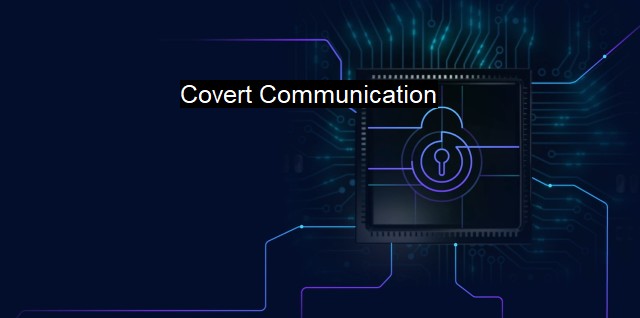What is Covert Communication?
Exploring Covert Communication in Cybersecurity: Detection and Prevention Techniques
Covert communication is a method of exchanging information that hides the existence of the communication. It is fundamentally different from the conventional techniques which aim to protect the content of the communication while it's clear that communication is taking place. The goal of covert communication, also known as steganography, is to prevent an eavesdropper from even realizing that communication is happening at all.The primary function of covert communication is to conceal the information within another harmless-looking information. This allows the sender and receiver to keep the content of their communication confidential from third parties. In the digital world, this can involve techniques like hiding information within digital images, audio files, video files, or even within the seemingly random noise that exists on all communication channels.
Communication between two parties is the most common and recognized form of covert communication. Yet, a less obvious form also exists categorized as covert channels. These channels are created when information flows in an unconventional way between two different spaces that should not naturally transfer information. An example of this could be using the timing of a system function in a piece of software to transmit information.
The field of cybersecurity has taken a keen interest in covert communication because of the role it plays in both protecting information and in malicious activities. The technology is not inherently nefarious but it can be from seaweed to propagate viruses, ransomware, and other types of malware. Given that the existence of communication can be oblivious to the conventional defenses like antiviruses, covert channels pose a significant challenge in combating cyber threats. an attacker may launder and control a network of computers without the user's knowledge, as the communication could go unnoticed by typical monitoring tools.
Developers of antivirus programs typically focus on identifying and eradicating the harmful code within the software. Therefore, covert communication can allow sophisticated attackers to bypass such defenses by disguising the harmful code within the regular operations of a computer. To make things worse, covert communication can potentially leave no trace as it may be programmed to self-erase after fulfilling its desired goal.
Antivirus software, typically looking for predetermined patterns indicative of harmful elements, are fundamentally limited in detecting covert communication. Therefore, it is an area demanding special attention and resources from the cybersecurity industry and one that necessitates the development of innovative defensive technologies.
Covert communication challenges the traditional norms and assumptions underlying our understanding and approach to cybersecurity. With it, the fundamental question is not "Are the contents of the communication protected?" but, "Is there any communication taking place?"
It's important to remember that these covert techniques are nothing more than tools that can be UX for both protective and harmful objectives. From a security standpoint, awareness and scrutiny are paramount. Using methods such as traffic anomaly detection and advanced heuristics can be helpful in identifying covert communication patterns.
To bolster defenses against covert communication, cybersecurity experts are increasingly researching methods to detect and disrupt these hidden channels and deploying advanced systems that combine artificial intelligence and machine learning to uncover unusual behaviors. various protocols are being put in place to limit how information can be passed between processes, reducing opportunities for covert channels to form in the first place.
While covert communication poses an intricate challenge a combination of a vigilant mindset, thorough understanding of covert communication mechanics and innovative technologies can help tackle this issue. Covert communication is an enduring cat-and-mouse game in the landscape of cybersecurity. But with continued vigilance and evolving countermeasures, the security industry can stay on to of this ever-changing field.

Covert Communication FAQs
What is covert communication in the context of cybersecurity and antivirus?
Covert communication refers to the practice of disguising communication between two parties in a way that is difficult to detect or intercept by third parties. This can include using encryption, steganography, or other techniques to conceal the content, sender, or recipient of a message.Why is covert communication a concern for cybersecurity and antivirus?
Covert communication can be used by attackers to evade detection and carry out malicious activities, such as stealing sensitive data, executing unauthorized commands, or communicating with malware or command-and-control servers. As a result, antivirus and other security systems need to be able to detect and analyze covert communication in order to identify and prevent cyber threats.What are some common techniques used for covert communication in cybersecurity?
Some common techniques for covert communication include encryption, which scrambles the content of a message so that only the intended recipient can read it; steganography, which hides information within seemingly innocuous files such as images or documents; and tunneling, which encapsulates communication within another protocol to mask its origin and destination.How can antivirus software detect and prevent covert communication?
Antivirus software can use a variety of techniques to detect and prevent covert communication, including behavioral analysis, signature-based detection, and machine learning algorithms. By analyzing network traffic and communication patterns, antivirus can identify suspicious activity that may indicate the presence of covert communication. Additionally, antivirus can detect known signatures of malware or other threats that may be communicating covertly, and block or quarantine them to prevent further damage.| | A | | | B | | | C | | | D | | | E | | | F | | | G | | | H | | | I | | | J | | | K | | | L | | | M | |
| | N | | | O | | | P | | | Q | | | R | | | S | | | T | | | U | | | V | | | W | | | X | | | Y | | | Z | |
| | 1 | | | 2 | | | 3 | | | 4 | | | 7 | | | 8 | | |||||||